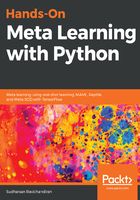
Learning to learn gradient descent by gradient descent
Now, we will see one of the interesting meta learning algorithms called learning to learn gradient descent by gradient descent. Isn't the name kind of daunting? Well, in fact, it is one of the simplest meta learning algorithms. We know that, in meta learning, our goal is to learn the learning process. In general, how do we train our neural networks? We train our network by computing loss and minimizing the loss through gradient descent. So, we optimize our model using gradient descent. Instead of using gradient descent can we learn this optimization process automatically?
But how can we learn this? We replace our traditional optimizer (gradient descent) with the Recurrent Neural Network (RNN). But how does this work? How can we replace gradient descent with RNN? If you examine closely, what are we really doing in gradient descent? It is basically a sequence of updates from the output layer to the input layer and we store these updates in a state. So, we can use RNN and store the updates in an RNN cell.
So, the main idea of this algorithm is to replace gradient descent with RNN. But the question is how do RNNs learn? How can we optimize the RNN? For optimizing an RNN, we use gradient descent. So, in a nutshell, we are learning to perform gradient descent through an RNN and that RNN is optimized by gradient descent and that's what is meant by the name learning to learn gradient descent by gradient descent.
We call our RNN, an optimizer and our base network, an optimizee. Let's say we have a model  parameterized by some parameter
parameterized by some parameter  . We need to find this optimal parameter
. We need to find this optimal parameter  , so that we can minimize the loss. In general, we find this optimal parameter through gradient descent, but now we use the RNN for finding this optimal parameter. So the RNN (optimizer) finds the optimal parameter and sends it to the optimizee (base network); the optimizee uses this parameter, computes the loss, and sends the loss to the RNN. Based on the loss, the RNN optimizes itself through gradient descent and updates the model parameter
, so that we can minimize the loss. In general, we find this optimal parameter through gradient descent, but now we use the RNN for finding this optimal parameter. So the RNN (optimizer) finds the optimal parameter and sends it to the optimizee (base network); the optimizee uses this parameter, computes the loss, and sends the loss to the RNN. Based on the loss, the RNN optimizes itself through gradient descent and updates the model parameter  .
.
Confusing? Look at the following diagram: our optimizee (base network) is optimized through our optimizer (RNN). The optimizer sends the updated parameters—that is, weights—to the optimizee and the optimizee uses these weights, calculates the loss, and sends the loss to the optimizer; based on the loss, the optimizer improves itself through gradient descent:

Let's say our base network (optimizee) is parameterized by  and our RNN (optimizer) is parameterized by
and our RNN (optimizer) is parameterized by  . What is the loss function of the optimizer? We know that the optimizer's role (RNN) is to reduce the loss of the optimizee (base network). So the loss of our optimizer is the average loss of the optimizee and it can be represented as follows:
. What is the loss function of the optimizer? We know that the optimizer's role (RNN) is to reduce the loss of the optimizee (base network). So the loss of our optimizer is the average loss of the optimizee and it can be represented as follows:

How do we minimize this loss? We minimize this loss through gradient descent by finding the right  . Okay, what does the RNN take as input and what output would it return? Our optimizer, that is, our RNN, takes as input the gradient of optimizee
. Okay, what does the RNN take as input and what output would it return? Our optimizer, that is, our RNN, takes as input the gradient of optimizee as well as its previous state
as well as its previous state  and returns output, an update
and returns output, an update  that can minimize the loss of our optimizee. Let's denote our RNN by a function
that can minimize the loss of our optimizee. Let's denote our RNN by a function  :
:

In the previous equation, the following applies:
 is the gradient of our model (optimizee)
is the gradient of our model (optimizee)  , that is,
, that is, 
 is the hidden state of the RNN
is the hidden state of the RNN is the parameter for the RNN
is the parameter for the RNN- Outputs
 and
and  is the update and next state of the RNN respectively
is the update and next state of the RNN respectively
So, we update our model parameter values using  .
.
As you can see in the following diagram, our optimizer  at a time t, takes in a hidden state
at a time t, takes in a hidden state  and a gradient of
and a gradient of  as
as  as inputs, computes
as inputs, computes  and sends it to our optimizee, where it is added with
and sends it to our optimizee, where it is added with  and becomes
and becomes  for an update at the next time step:
for an update at the next time step:

So, in this way, we learn the gradient descent optimization through gradient descent.